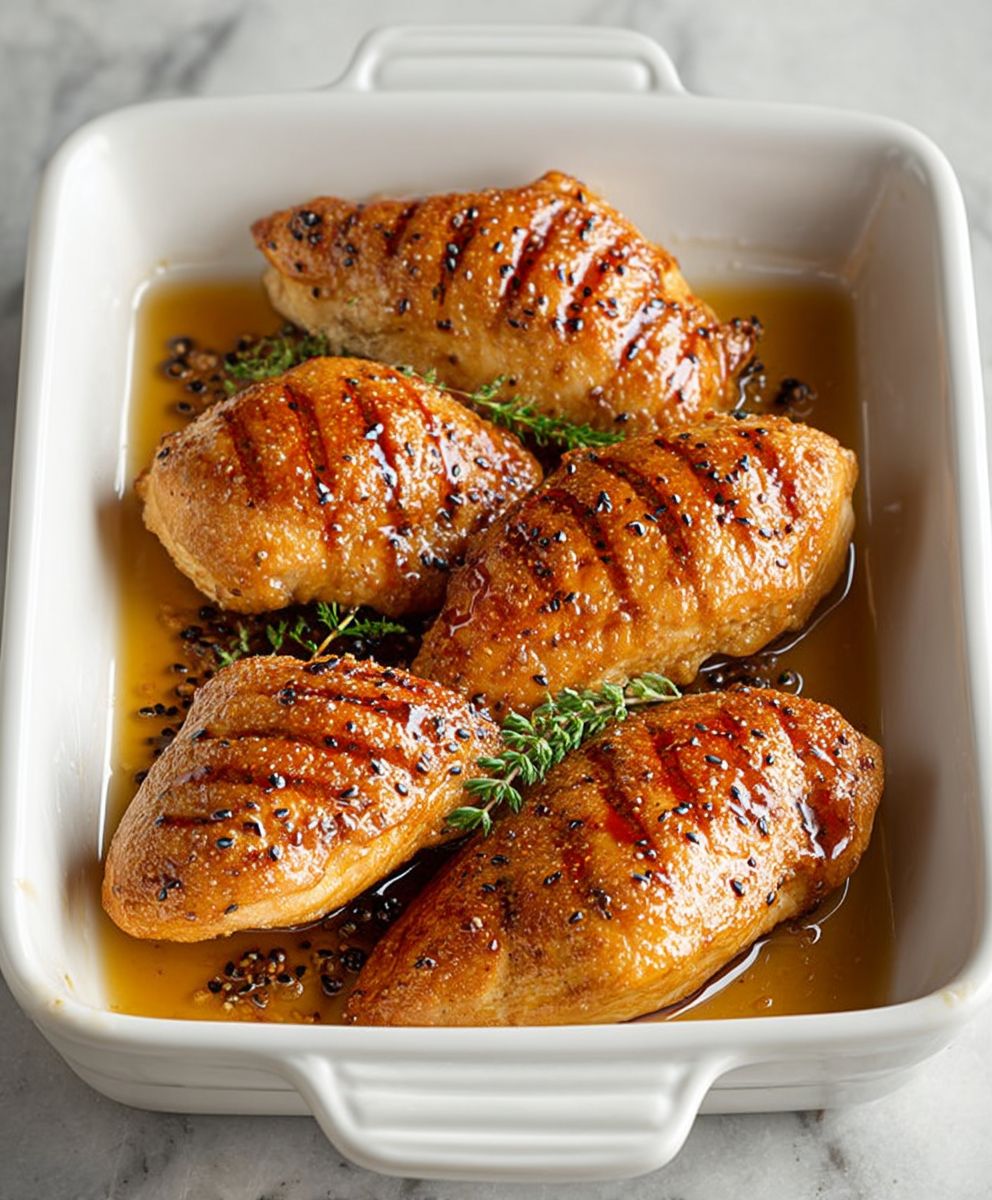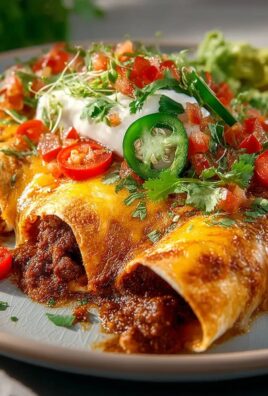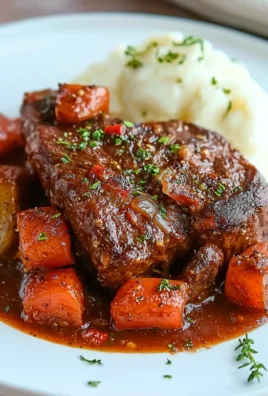Maple Balsamic Chicken: Prepare to be amazed by this incredibly flavorful and surprisingly simple dish that will elevate your weeknight dinners! Imagine tender, juicy chicken glazed with a sweet and tangy sauce that’s both sophisticated and comforting. This isn’t just another chicken recipe; it’s an experience.
While the exact origins of combining maple syrup and balsamic vinegar in a savory dish are somewhat modern, the inspiration draws from centuries of culinary tradition. Balsamic vinegar, originating in Italy, has long been prized for its complex sweetness and acidity, while maple syrup, a gift from North American forests, offers a unique, earthy sweetness. The marriage of these two ingredients creates a symphony of flavors that dance on your palate.
People adore Maple Balsamic Chicken for its incredible versatility and ease of preparation. It’s a dish that feels fancy enough for a dinner party yet is quick enough to whip up on a busy weeknight. The combination of sweet maple syrup, tangy balsamic vinegar, and savory chicken creates an irresistible flavor profile. The chicken becomes incredibly tender and moist, and the glaze caramelizes beautifully, creating a delightful sticky texture that everyone loves. Plus, it pairs perfectly with a variety of sides, from roasted vegetables to creamy mashed potatoes, making it a guaranteed crowd-pleaser. Get ready to discover your new favorite chicken recipe!
Ingredients:
- For the Chicken:
- 4 boneless, skinless chicken breasts (about 6-8 ounces each)
- 1 tablespoon olive oil
- 1/2 teaspoon salt
- 1/4 teaspoon black pepper
- 1/4 teaspoon garlic powder
- 1/4 teaspoon onion powder
- For the Maple Balsamic Glaze:
- 1/4 cup balsamic vinegar
- 1/4 cup pure maple syrup
- 2 tablespoons Dijon mustard
- 1 tablespoon soy sauce (low sodium preferred)
- 1 clove garlic, minced
- 1/2 teaspoon dried thyme
- 1/4 teaspoon red pepper flakes (optional, for a little heat)
- Optional Garnishes:
- Fresh parsley, chopped
- Sesame seeds
- Green onions, thinly sliced
Preparing the Chicken and the Glaze
- Prepare the Chicken: Pat the chicken breasts dry with paper towels. This helps them brown nicely. Season them generously with salt, pepper, garlic powder, and onion powder. Make sure to coat both sides evenly.
- Make the Maple Balsamic Glaze: In a small bowl, whisk together the balsamic vinegar, maple syrup, Dijon mustard, soy sauce, minced garlic, dried thyme, and red pepper flakes (if using). Whisk until everything is well combined and the glaze is smooth. Taste and adjust the seasonings if needed. You might want a touch more maple syrup for sweetness or a dash more balsamic for tang.
Cooking the Chicken
- Sear the Chicken: Heat the olive oil in a large skillet over medium-high heat. Once the oil is shimmering (but not smoking!), carefully place the chicken breasts in the skillet. Make sure not to overcrowd the pan; you might need to cook them in batches. Sear the chicken for about 4-5 minutes per side, or until they are nicely browned. The browning is important because it adds flavor and texture.
- Add the Glaze: Reduce the heat to medium. Pour the maple balsamic glaze over the chicken breasts in the skillet. Let the glaze simmer and thicken, coating the chicken evenly.
- Simmer and Cook Through: Continue to cook the chicken in the glaze for about 8-10 minutes, or until the chicken is cooked through and the internal temperature reaches 165°F (74°C). Use a meat thermometer to ensure accuracy. During this time, spoon the glaze over the chicken frequently to keep it moist and flavorful. The glaze will reduce and become sticky, creating a beautiful coating on the chicken. Be careful not to burn the glaze; if it starts to get too thick or dark, reduce the heat to low.
- Rest the Chicken: Once the chicken is cooked through, remove the skillet from the heat. Let the chicken rest in the skillet for a few minutes before serving. This allows the juices to redistribute, resulting in a more tender and flavorful chicken.
Serving Suggestions
- Serve and Garnish: Transfer the maple balsamic chicken to a serving plate. Spoon any remaining glaze from the skillet over the chicken. Garnish with fresh parsley, sesame seeds, and/or green onions, if desired.
- Pairing Suggestions: This maple balsamic chicken is delicious served with a variety of sides. Some great options include:
- Roasted Vegetables: Broccoli, asparagus, Brussels sprouts, or sweet potatoes are all excellent choices.
- Rice or Quinoa: These grains provide a healthy and satisfying base for the chicken.
- Mashed Potatoes: Creamy mashed potatoes are a classic pairing.
- Salad: A simple green salad with a light vinaigrette complements the richness of the chicken.
Tips and Variations
- Chicken Thighs: You can substitute boneless, skinless chicken thighs for the chicken breasts. Chicken thighs tend to be more flavorful and stay more moist during cooking. The cooking time may need to be adjusted slightly, so make sure the internal temperature reaches 165°F (74°C).
- Marinating the Chicken: For even more flavor, you can marinate the chicken in the maple balsamic glaze for at least 30 minutes, or up to overnight in the refrigerator. This will allow the flavors to penetrate the chicken, resulting in a more intense and delicious taste.
- Adding Vegetables to the Skillet: You can add vegetables like sliced bell peppers, onions, or mushrooms to the skillet along with the chicken. Cook them until they are tender-crisp before adding the glaze. This creates a one-pan meal that is both flavorful and convenient.
- Using Different Sweeteners: If you don’t have maple syrup, you can substitute honey or brown sugar. However, the flavor will be slightly different.
- Adjusting the Spice Level: If you prefer a spicier dish, you can add more red pepper flakes or a pinch of cayenne pepper to the glaze.
- Baking the Chicken: If you prefer to bake the chicken, preheat your oven to 375°F (190°C). Sear the chicken in a skillet as directed, then transfer it to a baking dish. Pour the glaze over the chicken and bake for 20-25 minutes, or until the chicken is cooked through.
- Grilling the Chicken: You can also grill the chicken. Preheat your grill to medium heat. Grill the chicken for about 5-7 minutes per side, or until it is cooked through. Brush the chicken with the maple balsamic glaze during the last few minutes of grilling.
- Make it Ahead: You can prepare the glaze ahead of time and store it in the refrigerator for up to a week. You can also cook the chicken ahead of time and reheat it when you’re ready to serve.
Detailed Explanation of Ingredients
Chicken Breasts:
I prefer using boneless, skinless chicken breasts for this recipe because they cook quickly and evenly. However, you can use bone-in, skin-on chicken breasts if you prefer. Just be sure to adjust the cooking time accordingly. When selecting chicken breasts, look for ones that are plump and firm to the touch. Avoid chicken that looks pale or has a slimy texture.
Olive Oil:
Olive oil is used to sear the chicken and prevent it from sticking to the skillet. You can use any type of olive oil, but I recommend using extra virgin olive oil for the best flavor. If you don’t have olive oil, you can use another type of cooking oil, such as canola oil or vegetable oil.
Salt, Pepper, Garlic Powder, and Onion Powder:
These seasonings are used to flavor the chicken. Feel free to adjust the amounts to your liking. You can also add other seasonings, such as paprika, chili powder, or cumin.
Balsamic Vinegar:
Balsamic vinegar adds a tangy and slightly sweet flavor to the glaze. Look for a good quality balsamic vinegar for the best results. If you don’t have balsamic vinegar, you can substitute red wine vinegar or apple cider vinegar, but the flavor will be slightly different.
Maple Syrup:
Pure maple syrup adds sweetness and a rich flavor to the glaze. Be sure to use pure maple syrup, not pancake syrup, which is made with corn syrup and artificial flavors. If you don’t have maple syrup, you can substitute honey or brown sugar, but the flavor will be slightly different.
Dijon Mustard:
Dijon mustard adds a tangy and slightly spicy flavor to the glaze. You can use any type of Dijon mustard, but I recommend using a smooth Dijon mustard for the best texture. If you don’t have Dijon mustard, you can substitute yellow mustard, but the flavor will be different.
Soy Sauce:
Soy sauce adds a savory and umami flavor to the glaze. I recommend using low-sodium soy sauce to control the saltiness of the dish. If you don’t have soy sauce, you can substitute tamari or coconut aminos.
Garlic:
Fresh garlic adds a pungent and aromatic flavor to the glaze. I recommend using fresh garlic for the best flavor. If you don’t have fresh garlic, you can substitute garlic powder, but the flavor will be less intense.
Dried Thyme:
Dried thyme adds an earthy and slightly minty flavor to the glaze. You can use fresh thyme if you prefer, but you’ll need to use about three times as much. If you don’t have dried thyme, you can substitute dried rosemary or dried oregano.
Red Pepper Flakes:
Red

Conclusion:
This Maple Balsamic Chicken recipe isn’t just another weeknight dinner; it’s a flavor explosion waiting to happen! The sweet maple syrup perfectly complements the tangy balsamic vinegar, creating a glaze that’s both sophisticated and comforting. The chicken emerges from the oven beautifully caramelized, incredibly moist, and bursting with a taste that will have everyone asking for seconds. Trust me, this is one you’ll want to add to your regular rotation.
But the best part? It’s incredibly versatile! Serve it over a bed of fluffy quinoa or couscous to soak up all that delicious sauce. For a low-carb option, try pairing it with roasted vegetables like broccoli, asparagus, or Brussels sprouts. A simple side salad with a light vinaigrette also works wonders to balance the richness of the chicken.
Looking for variations? You’ve got options! If you’re feeling adventurous, add a pinch of red pepper flakes to the marinade for a touch of heat. Or, try substituting the maple syrup with honey for a slightly different flavor profile. For a more intense balsamic flavor, reduce the balsamic vinegar in a saucepan until it thickens slightly before adding it to the marinade. This will create an even richer and more concentrated glaze.
Another fantastic variation is to use chicken thighs instead of breasts. Chicken thighs are naturally more flavorful and stay incredibly juicy during cooking. Just be sure to adjust the cooking time accordingly, as thighs typically take a bit longer to cook through. You could even use bone-in, skin-on chicken thighs for extra crispy skin and even more flavor!
Don’t be afraid to experiment with different herbs and spices too! A sprinkle of dried thyme, rosemary, or oregano can add a lovely herbaceous note to the dish. A dash of smoked paprika can also bring a subtle smoky flavor that complements the maple and balsamic beautifully.
I truly believe this Maple Balsamic Chicken recipe is a winner. It’s easy enough for a weeknight meal but impressive enough to serve to guests. It’s a crowd-pleaser that’s sure to become a family favorite.
So, what are you waiting for? Head to your kitchen, gather your ingredients, and give this recipe a try! I’m confident you’ll love it as much as I do. And when you do, please come back and share your experience in the comments below! I’d love to hear what you think, what variations you tried, and how you served it. Your feedback is invaluable and helps other readers discover new and exciting ways to enjoy this delicious dish.
I can’t wait to hear about your culinary adventures with this recipe. Happy cooking! Let me know if you have any questions, and I’ll do my best to answer them. Enjoy!
Maple Balsamic Chicken: A Delicious & Easy Recipe
Tender and juicy chicken breasts coated in a sweet and tangy maple balsamic glaze. This easy recipe is perfect for a weeknight dinner and can be served with a variety of sides.
Ingredients
- 4 boneless, skinless chicken breasts (about 6-8 ounces each)
- 1 tablespoon olive oil
- 1/2 teaspoon salt
- 1/4 teaspoon black pepper
- 1/4 teaspoon garlic powder
- 1/4 teaspoon onion powder
- 1/4 cup balsamic vinegar
- 1/4 cup pure maple syrup
- 2 tablespoons Dijon mustard
- 1 tablespoon soy sauce (low sodium preferred)
- 1 clove garlic, minced
- 1/2 teaspoon dried thyme
- 1/4 teaspoon red pepper flakes (optional, for a little heat)
- Fresh parsley, chopped
- Sesame seeds
- Green onions, thinly sliced
Instructions
- Prepare the Chicken: Pat the chicken breasts dry with paper towels. Season them generously with salt, pepper, garlic powder, and onion powder. Make sure to coat both sides evenly.
- Make the Maple Balsamic Glaze: In a small bowl, whisk together the balsamic vinegar, maple syrup, Dijon mustard, soy sauce, minced garlic, dried thyme, and red pepper flakes (if using). Whisk until everything is well combined and the glaze is smooth. Taste and adjust the seasonings if needed. You might want a touch more maple syrup for sweetness or a dash more balsamic for tang.
- Sear the Chicken: Heat the olive oil in a large skillet over medium-high heat. Once the oil is shimmering (but not smoking!), carefully place the chicken breasts in the skillet. Make sure not to overcrowd the pan; you might need to cook them in batches. Sear the chicken for about 4-5 minutes per side, or until they are nicely browned. The browning is important because it adds flavor and texture.
- Add the Glaze: Reduce the heat to medium. Pour the maple balsamic glaze over the chicken breasts in the skillet. Let the glaze simmer and thicken, coating the chicken evenly.
- Simmer and Cook Through: Continue to cook the chicken in the glaze for about 8-10 minutes, or until the chicken is cooked through and the internal temperature reaches 165°F (74°C). Use a meat thermometer to ensure accuracy. During this time, spoon the glaze over the chicken frequently to keep it moist and flavorful. The glaze will reduce and become sticky, creating a beautiful coating on the chicken. Be careful not to burn the glaze; if it starts to get too thick or dark, reduce the heat to low.
- Rest the Chicken: Once the chicken is cooked through, remove the skillet from the heat. Let the chicken rest in the skillet for a few minutes before serving. This allows the juices to redistribute, resulting in a more tender and flavorful chicken.
- Serve and Garnish: Transfer the maple balsamic chicken to a serving plate. Spoon any remaining glaze from the skillet over the chicken. Garnish with fresh parsley, sesame seeds, and/or green onions, if desired.
Notes
- Chicken Thighs: You can substitute boneless, skinless chicken thighs for the chicken breasts. Chicken thighs tend to be more flavorful and stay more moist during cooking. The cooking time may need to be adjusted slightly, so make sure the internal temperature reaches 165°F (74°C).
- Marinating the Chicken: For even more flavor, you can marinate the chicken in the maple balsamic glaze for at least 30 minutes, or up to overnight in the refrigerator. This will allow the flavors to penetrate the chicken, resulting in a more intense and delicious taste.
- Adding Vegetables to the Skillet: You can add vegetables like sliced bell peppers, onions, or mushrooms to the skillet along with the chicken. Cook them until they are tender-crisp before adding the glaze. This creates a one-pan meal that is both flavorful and convenient.
- Using Different Sweeteners: If you don’t have maple syrup, you can substitute honey or brown sugar. However, the flavor will be slightly different.
- Adjusting the Spice Level: If you prefer a spicier dish, you can add more red pepper flakes or a pinch of cayenne pepper to the glaze.
- Baking the Chicken: If you prefer to bake the chicken, preheat your oven to 375°F (190°C). Sear the chicken in a skillet as directed, then transfer it to a baking dish. Pour the glaze over the chicken and bake for 20-25 minutes, or until the chicken is cooked through.
- Grilling the Chicken: You can also grill the chicken. Preheat your grill to medium heat. Grill the chicken for about 5-7 minutes per side, or until it is cooked through. Brush the chicken with the maple balsamic glaze during the last few minutes of grilling.
- Make it Ahead: You can prepare the glaze ahead of time and store it in the refrigerator for up to a week. You can also cook the chicken ahead of time and reheat it when you’re ready to serve.





Leave a Comment